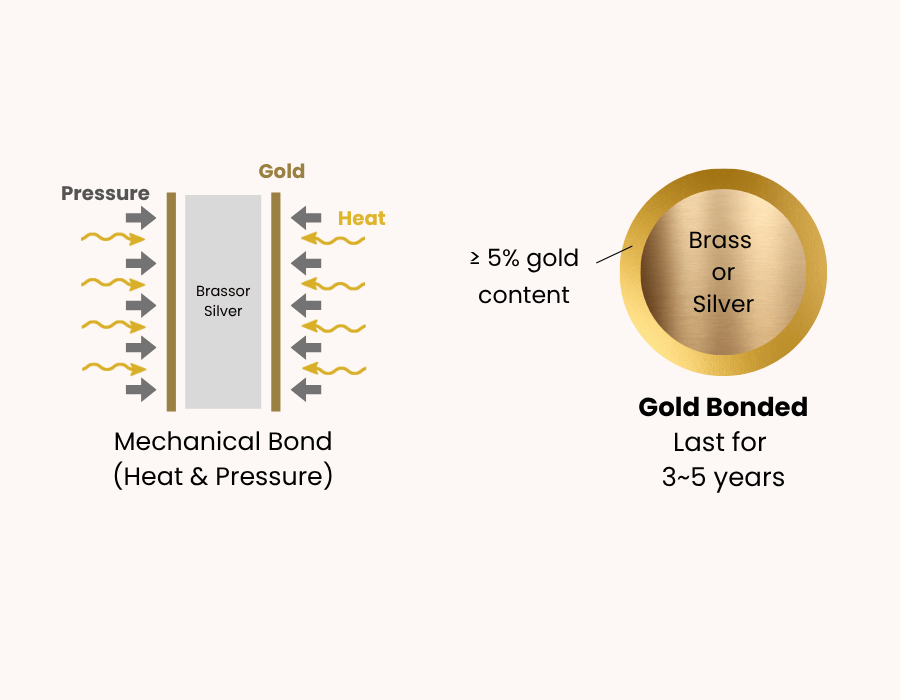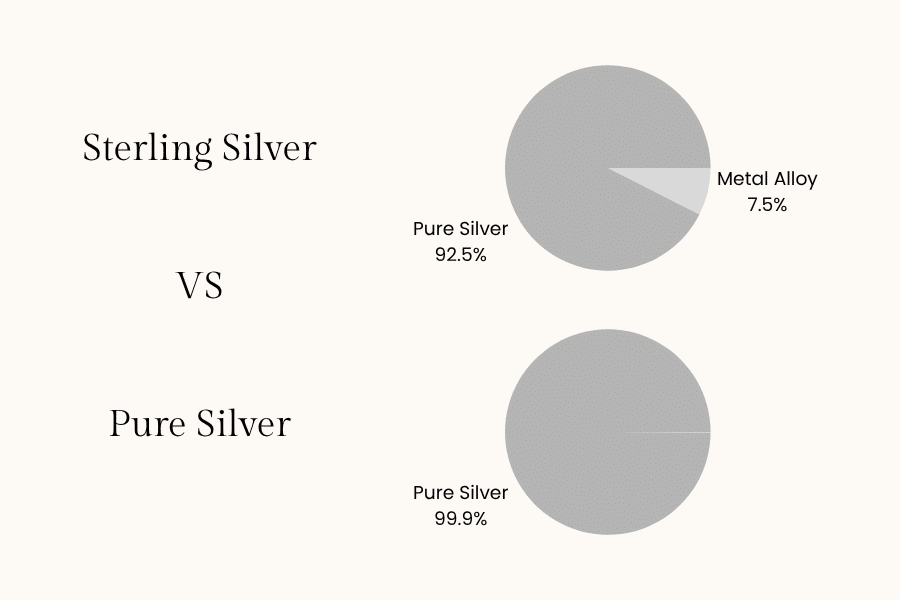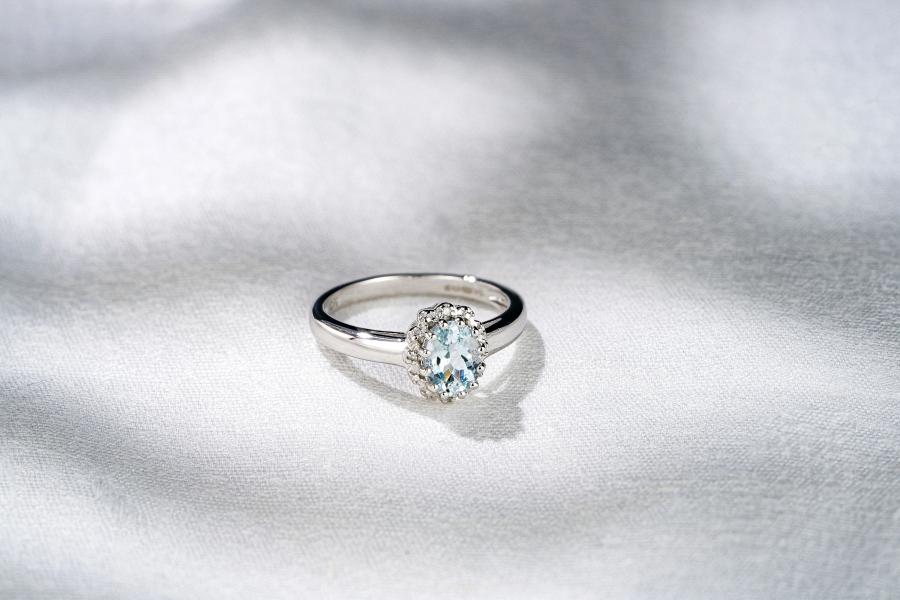Before buying gold jewelry, it’s important to understand what you’re buying. There are variations of gold jewelry, such as gold filled, gold plated, and gold vermeil. It’s easy to assume these 3 are the same because they have the same appearance at first glance, but they are different.
Join us as we unveil the key differences and similarities in gold filled vs plated vs vermeil jewelry, so you can make an informed choice for your brand reputation, consumers’ preferences, and long-term wearability.
| Feature | Gold Plated | Gold Vermeil | Gold Filled |
| Gold Layer Thickness | Average 0.05 microns | At least 2.5 microns | ~5% of item’s weight |
| Base Metal | Brass, Silver or Stainless Steel | Sterling Silver (925) | Brass or Silver |
| Manufacturing Method | 1. Electroplating (gold plated on brass/silver) 2. PVD Coated (gold plated on SS) | Electroplating | 1. Electroplating (chemical bond) 2. Pressure & Heat (mechanical bond) |
| Durability | PVD gold plated are highly tarnish-resistant and durable than electroplated gold plated jewelry | Moderate to High | High |
| Cost | Low | Mid to High | Mid-range |
What is Gold Plated Jewelry?
This type of gold jewelry is composed of a base metal (usually copper, brass, or stainless steel) and a thin layer of gold. The thin layer of gold, which is averagely 0.05 microns thick, is electroplated or PVD-coated on the base metal to form a gold plated jewelry.
What is Gold Vermeil Jewelry?
Gold vermeil jewelry is an advanced version of gold plating. Firstly, it uses sterling silver as the base metal, which is stronger and more attractive. Then, it’s electroplated with at least 2.5 microns of gold layer, making the jewelry tougher and last longer.
What is Gold Filled Jewelry?
Gold filled jewelry is composed of a base metal (usually brass or silver) and a thick layer of gold plating, which is the closest to looking like solid gold. If you’re wondering how many microns is gold filled? It’s not measured by microns. Rather, the gold layer must constitute at least 5% of the jewelry total weight.
Gold Filled vs. Plated vs. Vermeil: What’s the Difference?
Now, let’s explore the major differences between gold filled vs gold plated vs gold vermeil jewelry:
Key Difference: Thickness & Base Metal
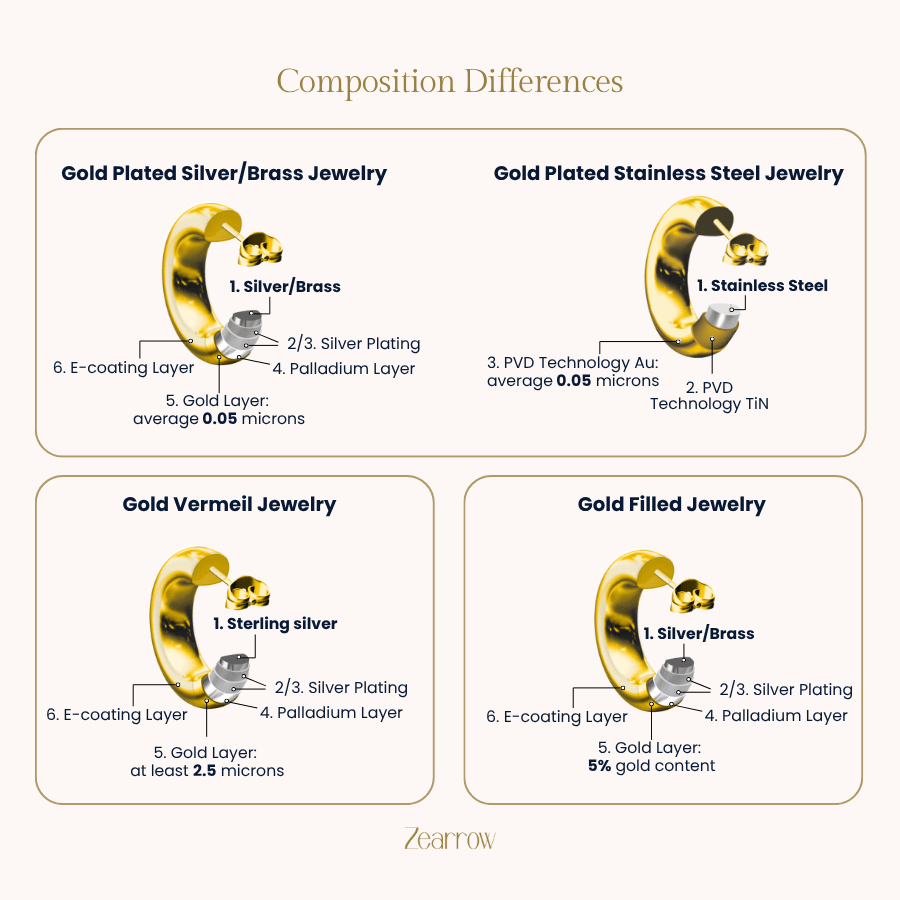
- Gold Plated: Uses brass or silver as the base metal, and it’s electroplated with about 0.05 microns of gold. On other occasions, stainless steel is used as the base metal and it’s PVD-coated with the gold layer, resulting in a PVD gold plated jewelry.
- Gold Vermeil: Uses sterling silver as the base metal and it’s electroplated with a minimum thickness of 2.5 microns gold.
- Gold Filled: Uses brass or silver as the base metal, and a thick layer of gold plating. According to the Federal Trade Commission (FTC) regulations, gold filled jewelry must contain a minimum of 5% in the jewelry’s total weight.
Manufacturing Method Difference
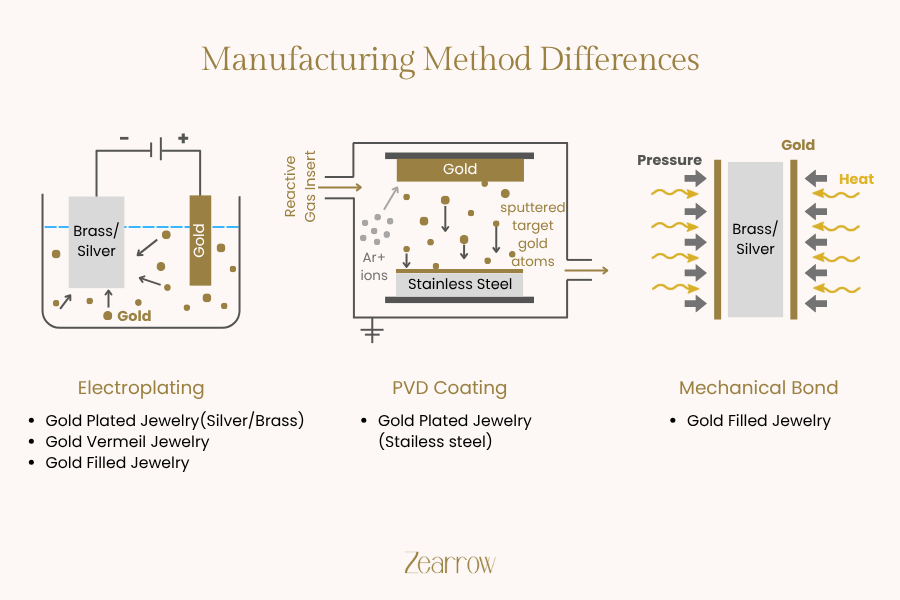
- Gold Plated: Can be manufactured in 2 methods (PVD coating or Electroplating) depending on the base metal. Brass and silver involves electroplating where the gold is deposited on the base metal using electric current. Stainless steel, on the other hand, involves PVD coating, where the gold is vaporized and deposited on the base metal.
- Gold Vermeil: This type of jewelry is made through electroplating. The gold layer is deposited firmly on the base metal (sterling silver) using electric current.
- Gold Filled: There are 2 manufacturing methods for gold filled jewelry – mechanical bonding and chemical bonding. For mechanical bonding, heat and pressure are used to mechanically bond a layer of solid gold to the core metal. Chemical bonding, on the other hand, attaches to the gold layer through electroplating.
Durability, Tarnish Resistance & Hypoallergenic
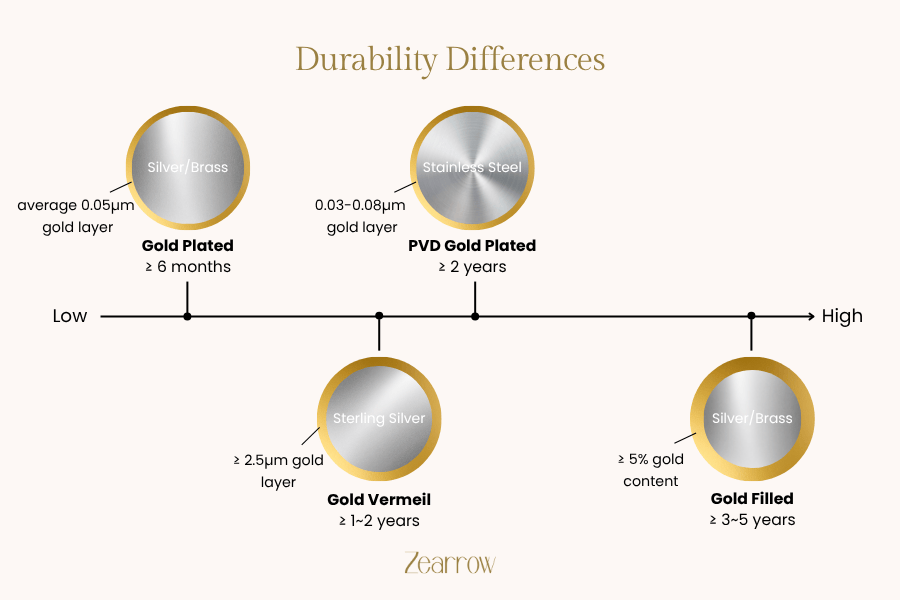
- Gold Plated: This jewelry contains only a thin electroplated layer of gold on its base metal (silver or brass). The gold layer wears off and tarnishes quickly with regular use; it can last for at least 6 months. Also, this jewelry is not always hypoallergenic. The hypoallergenic nature depends on the base metal whether silver or brass. But when its PVD gold plated on stainless steel, there’s better tarnish resistance and hypoallergenic properties. Due to the PVD technique, it’s less likely to discolor and keep its shine over time, even with everyday wear for over a year. PVD gold plated can last for at least 2 years.
- Gold Vermeil: While the gold layer is also electroplated like gold plated jewelry, this jewelry is thicker thanks to its minimum of 2.5 gold microns layer. It’s more durable and tarnish-resistant than gold plating but not as much as gold filled. How long does gold vermeil jewelry last? It lasts for at least 1-2 years. Since the base metal is sterling silver and it has a thicker gold layer, you can be rest assured that there won’t be any allergic concern; it’s suitable for even people with sensitive skin.
- Gold Filled: This jewelry has a thick, mechanically/chemically bonded gold layer (typically 5% of the item’s total weight). This makes it highly resistant to wear and chipping. Gold filled jewelry lasts at least 3-5 years, and the thick gold layer makes it safe for most sensitive skin types.
Cost & Price Difference
A notable difference between gold filled vs plated vs vermeil is their price. This is majorly influenced by their varying base metals and thickness of gold coating.
Gold Filled > Gold Vermeil > Gold Plated
- Gold filled jewelry is most expensive because of the higher content of gold, which makes up at least 5% of the jewelry’s total weight. Is gold filled jewelry real gold because of this? Yes, the plated layer is real gold, although the base metal is either brass or silver.
- Gold vermeil jewelry is more expensive than gold plated pieces because it uses a sterling silver base metal and the applied gold layer is a minimum of 2.5 microns.
- Gold plated jewelry is the cheapest. It uses affordable base metals like copper and brass, and the applied gold layer is thin (average 0.05 microns).
Gold Filled vs. Plated vs. Vermeil: What’s the Same?
Here are the main similarities you will notice when comparing gold filled vs gold plated vs gold vermeil jewelry:
All Contain Real Gold
Each of these gold jewelry contains real gold. They are all layered with genuine gold, though the thickness and application methods are different. The layered gold provides that authentic golden look and some level of durability.
Appearance When New
All three options look equally beautiful at first glance, especially in high-polish finishes. The golden finish, luster, and overall aesthetic can’t be differentiated with naked eyes, which makes it more important to buy from a professional custom jewelry manufacturer with verifiable quality production.
Which Option is More Recommended for Your Brand?
Are you considering which to buy between gold filled vs gold plated vs gold vermeil for your brand? These are essential factors you should consider:
Key Factors When Choosing Between Them
- Purpose & Frequency of Wear: Gold filled and gold vermeil are ideal for daily wear items because they offer more durability, while gold plating is better for occasional statement pieces that prioritize affordability over longevity.
- Budget Consideration: Gold filled is more expensive, gold vermeil is priced at a moderate cost, while gold plated jewelry is most affordable.
- Skin Sensitivity: Customers with sensitive skin should avoid gold plated options because the thin gold layer wears off quickly, exposing their skin to the cheap base metals that can cause reaction. Gold filled and gold vermeil offer better protection.
Gold Plated: Everyday & Affordable Fashion
Best for brands targeting budget-conscious customers who want trendy pieces for short-term wear. Expect at least 6 months of usage with proper care.
Gold Vermeil: Demi-fine Jewelry
Ideal for brands positioning themselves as the go-to for durable and hypoallergenic gold jewelry pieces but at a more affordable price than solid gold. Expect 1-2 years of usage with proper care.
Gold Filled: Fine Jewelry
Recommended for brands who want to offer the closest alternative to solid gold. Suitable for timeless and investment-worthy pieces. Expect 3-5 years of usage with proper care.
How to Tell the Difference by Look or Stamp?
At first glance, gold-filled, gold-plated, and gold vermeil jewelry can all look similar. But if you’re trying to determine which type you’re buying (or selling), there are key visual and physical clues, especially in the jewelry stamps and hallmarks.
- Gold Plated: Often marked with “GP”, “GEP” (gold electroplated), or “HGE” (heavy gold electroplate). Some cheaper pieces may not have any stamp at all.
- Gold Vermeil: May be stamped with “925”, “Sterling”, or “925 Vermeil.” The key is that it always has a sterling silver base, which must be clearly indicated.a
- Gold Filled: Typically marked with “GF” or “1/20 14K GF”, meaning 1/20th of the piece’s weight is 14-karat gold. Other common formats: “12K GF” or “10K GF.”
Why Does Gold Plated Jewelry Turn Skin Green?
Gold plated jewelry is coated with a very thin layer of gold (averagely 0.5 microns), which wears off easily. After it wears off, the skin is exposed to direct contact with the base metal, which makes the skin green.
Is Gold Filled Jewelry Real Gold?
Yes, gold filled jewelry is real gold. A minimum of 5% of the total jewelry weight is made up of genuine gold, making it more similar to solid gold than gold plated or gold vermeil.
Conclusion
In summary of the gold filled vs plated vs vermeil comparison, gold filled is a composition of brass or silver with a very thick layer of gold (that makes up 5% of the item’s weight). Gold plated is a composition of either brass, silver, or stainless steel with a very thin layer of gold. Gold vermeil is made up of sterling silver and a 2.5 microns thick gold layer.
